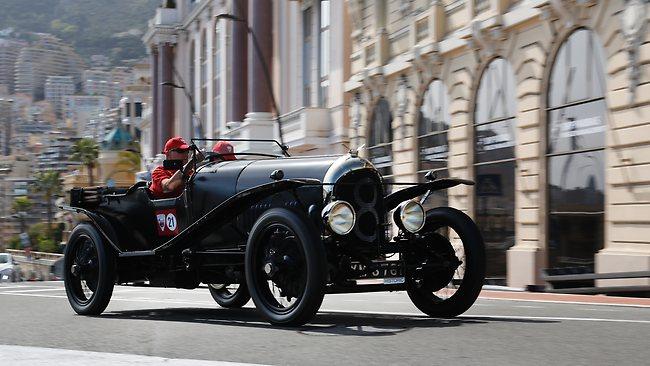Rallying call
THE four-day Louis Vuitton Classic car rally from Monte Carlo to Venice combines beautiful cars with the world's most spectacular roads.

IN April this year, 42 classic cars collectively worth an estimated $235 million set off from the Place du Casino in Monaco for a four-day, transalpine journey through France, Switzerland and Italy to finally arrive at Piazza San Giorgio in Venice.
If you know Venice you'll know that it's virtually impossible to reach San Giorgio by car, but more on that aspect of the journey later. This was no ordinary car rally. The 1400km Serenissima Run - derived from the formal name of what was once the republic of Venice - was organised by French luxury goods company Louis Vuitton and is the seventh such car rally run over the past two decades. And as Yves Carcelle, chief executive of Louis Vuitton, points out, a classic car rally is one thing, a classic car rally organised by a luxury goods company is something else altogether.
"A rally is a rally is a rally, but a Louis Vuitton Classic - I think all the parties involved can say - is very special," Carcelle told WISH at the prize-giving ceremony for the winner of the Serenissima Run on San Giorgio island. "The sense of detail and the organisation and the quality of the cars ... all that makes it very special."
The first Louis Vuitton Classic car rally was an equatorial run that went from Singapore to Kuala Lumpur in 1993; others followed. In China, for example, from Dalian to Beijing in 1998, and in Eastern Europe from Budapest to Prague in 2006. "For this [2012] rally, we wanted to go to a unique region of the world, which has always attracted travellers for its relaxed lifestyle and its extreme serenity," says Carcelle.
"It's funny because I talked with many of the participants - I wasn't there at the beginning in Monte Carlo, I just arrived in Verona and did the last leg of the rally - and many of them said that when Vuitton talked about a rally from Monaco to Venice they thought it would be like a nice gentle tour of the Riviera but, in fact, it was technically the most difficult rally we have done. With the mountains and the weather conditions, we had a real sense of adventure."
Competitors, who came from all over the world, were invited to take part by the president of the jury of the Louis Vuitton Classic Awards, renowned automobile expert Christian Philippsen. Monaco-based Philippsen began his automotive career in his native Belgium, working for the country's Ferrari importer. He then went to work for Michelin before leaving the motoring world to team up with Albert Uderzo to publish the Asterix comic books and is also responsible for the Parc Asterix theme park just outside of Paris. Since 1988, he has worked with a range of clients, including Louis Vuitton, Pininfarina and Finpiemonte, organising motoring events such as this one. So when it comes to organising the Serenissima Run, he simply opens his address book to find competitors. "I have a short-list of about 300 major collectors from around the world who own significant cars," Philippsen says over lunch in Venice after the rally.
"I know them all personally and some of them are very close friends. I contact them and tell them what we are planning to do and to get expressions of interest."
To enter the rally, competitors must pay a fee, which, while not insubstantial at a few thousand euros, is nothing compared to the transport and insurance costs of vehicles priced in excess of 100,000, a cost the drivers must cover.
"Out of the 300 people who I initially contacted, all 300 responded and said yes," says Philippsen. "And so a little bit later, when we sent the final entry forms, 120 people expressed an interest and then I had to reduce that to around 40 because that was the capacity of the event."
According to Philippsen, various considerations come into play when choosing the final competitors.
"One, of course, is the car," he says. "It has to be an exceptional car and we won't take duplicates. If we have several cars [that are] the same then the history and provenance of the car counts. The nationality of the owner counts because we want people from the whole world and not just Europeans and Americans, and then we want to make sure the group will somehow work together. The hardest part of my job is not to get the cars, the hardest part is to tell the people who have expressed an interest that we cannot accommodate them."
For the Serenissima Run, 18 competitors came from the US and represented the largest group. However, there were also drivers from countries including Britain, Italy, Mexico, France, Hong Kong, China and Pakistan, as well as the owner of one of the largest private car collections in Australia, Peter Briggs from Perth.
Briggs, an entrepreneur and former mining executive, was one of the original founders of the Diggers and Dealers mining conference. He has a collection of classic cars that once numbered 150 but recently has been reducing his collection; it now stands, he says, at "about 70 cars". The Serenissima Run was the fourth Louis Vuitton rally that Briggs has competed in - he drove in the Equator rally, the China rally and the Budapest to Prague rally - and for the Monte Carlo to Venice run he drove a 1922 Bentley 3L, a car he has owned for about 30 years.
A competitor in several other car rallies, he says the appeal of a Louis Vuitton one is that they're not run for commercial gain. "A lot of rallies today are just about making money," says Briggs. "Louis Vuitton spares no expense in putting this one on but they're not doing it to make money. Sure they're promoting a product, but their rallies are about the cars and the passion people have for them." Briggs and his wife Robin finished the Serenissima Run placed 10th overall. "I've been doing international rallies for more than 30 years," says Briggs.
"I don't do it to win - in a way, it's not really a race - but when you have the world's leading car collectors together as you do in this rally, all those guys are competitive guys and that naturally comes out when you get behind the wheel. But the main thing for me is to be around such a great collection of cars." The Bentley 3L gave Britain its first Le Mans victory in 1924 and Briggs' particular car finished fourth in the inaugural Le Mans 24-Hour race in 1923. Three other Bentleys, one from 1929 and two from 1931 also competed in the rally.
Competitors in the Louis Vuitton Classic are not allowed to use GPS navigation systems and instead are equipped with a large road book that details every single turn to guide them through the itineray. The rally winner is not simply the car that finishes first. As in other classiccar rallies, drivers compete in different classes and attempt to complete the various legs of the course at predetermined average speeds. They receive penalty points for deviating from those speeds and the driver with the fewest penalty points at the end of the rally is the winner.
According to Philippsen, many of the drivers are in it to win. "I was quite surprised when I looked at the final results because people will tell you they are just driving and enjoying the day but actually they were very competitive and it shows in the results," he says. "So we have some people who do very well, some people who try their best and some who just don't care and just enjoy the run."
The winner of the Serenissima Run was the father and son team of Giuseppe and Gianandrea Redaelli, who drove a 1923 Bugatti Type 23 Brescia Modifiee. In 1921, Bugatti won the first four places in the Italian Voiturettes Grand Prix at Brescia with a Type 13 car and the carmaker then built an improved version called the Brescia Modifiee, which is powered by a four-cylinder, 1.5L engine with a distinctive torpedo body shape and staggered seating arrangement. The same car also won the Louis Vuitton Budapest to Prague run in 2006.
The Redaelli father and son combination was an aspect to the winners that very much pleased Philippsen.
"The average age of the drivers, as you've probably observed, is not very young and, of course, you can't often afford such valuable cars when you are in your 20s," he says. "What we really encourage is family participation as it's the only way to progress because we have to pass this on somehow. We have many husband and wife teams and this year we had two father and son teams and we encourage that very much."
In fact, the majority of the competitors were husband and wife teams with one all-female team. "I think the Louis Vuitton brand is a contributing factor in encouraging women to participate," says Philippsen when asked if other classic-car rallies are as popular with women. "Most car rallies are macho events so I think what we have achieved to have husband and wife teams is very rare.
It's also a lot more civilised than most car events. We stay at nice hotels and eat at good restaurants and we go to places like Monte Carlo and Lake Como and Venice, and those places mean something to them."
The rally course also took in the northern Italian town of Fiesso d'Artico, where Louis Vuitton makes its shoes.
After lunch and a tour of the shoe workshop, competitors in the rally received a pair of Louis Vuitton shoes. Fiesso is about a 30-minute drive from Venice in a contemporary car (but it took some of the classic cars several hours) and while the smiles on the faces of the competitors might have been due to the fact that the finish line was in view, the new shoes no doubt added to their joy.
The rally course was put together by former French racing driver Rene Metge. He competed in the Le Mans 24-Hour race six times, was the winner of the French Touring Car Championship in 1982 and won the Dakar Rally three times (1981, 84 and 86). While the Serenissima Run was nowhere near as tough as the Dakar Rally, Metge says the route was not without its challenges. "After we had decided on the final itinerary we asked Mr Philippsen to choose the cars accordingly," he says.
"They had to be light and very sporty. There were many mountains and difficult parts so we had to take out big Bentleys and big Rolls-Royces."
As you would expect of someone who has competed in Le Mans and driven - and won - in the Dakar Rally, Metge likes a challenge. "I'm a specialist in impossible missions," he says. "And that's why I like to work with Louis Vuitton because they like to do things that can't be done. We had to bring the cars to San Giorgio island at a certain moment in the rally and so I asked someone in Venice to organise it. They said it was impossible because you can't bring cars to Venice. How can you do that they asked me?" His solution? A barge. At night.



